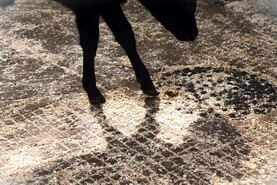Over the past five to 10 bloat in young dairy calves has become a more common complaint.
Occasional bloat is normal in both beef and dairy animals, but increasingly it is cropping up in calves in the first couple of weeks of their lives.
Bloat in calves caused by the abomasum or milk stomach swelling with gas, putting pressure on other organs. This can can lead to collapse and death in just six to12 hours.
Bloat in claves is different to that found in adult animals, where the rumen or main stomach bloats.
Calves with bloat often swell up on the right side, stop drinking and begin to grind their teeth – a sure sign of abdominal pain in calves or cows.
The cause
Bloat is caused by the rapid accumulation of gas in the milk stomach.This gas is often caused by a bacteria called clostridium perfringens. While this bacteria is often blamed for bloat, it is most likely poor management practices that allow or increase the spread of the condition.
Back to nature
If we look at why suckler calves are less prone to bloat, it can give us more of a better understanding of why dairy calves are more susceptible.
A suckler calf will drink small volumes of milk eight to10 times daily.
The milk contains 12.5% solids – an important aspect when it comes to milk replacers.
In dairy calves, more milk is fed at once, with potentially higher concentrations of solids.
Going above 15% solids is often where bloat issues arise.
Most cases of bloat I have seen develop where milk replacer is being fed, or when whole milk is given in poor hygiene.
The higher percentage of solids in milk replacer means that the milk is thicker and the stomach takes longer to empty, so feeding large volumes at once an create problems, especially in once-a-day-feeding systems.
Milk replacer
The quality of the milk replacer is also really important – always aim to use a high-quality milk replacer from animal protein source.
Using a skim replacer versus a whey one doesn’t seem to impact on bloat, but further research is needed here.
Being consistent with the timing of feeding can also help, space out feedings and get into a routine.
Feeding 3l of 12.5 % solids twice daily is one system I've seen that seems to do a good job in reducing bloat issues.
Hygiene
Hygiene is vital, good hygiene can make a dramatic difference in fighting clostridium perfringens at feeding time.
Though popular, tubing is often be poor at relieving bloat in calves. Generally a needle can be used to relive the pressure, though this should not be done in a standing calf.
Sit calves on their back, thus allowing gas to settle on the underneath of the belly. Then press the needle with low pressure to release the gas. I often couple this with oral doses of penicillin for two days and skip one milk feeding.
As always though, prevention is the preferred option, with good feeding routines, consistency of feed and hygiene the best ways to stave off bloat in calves.






 This is a subscriber-only article
This is a subscriber-only article










SHARING OPTIONS: